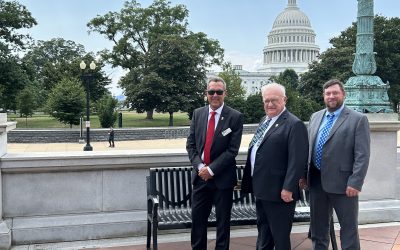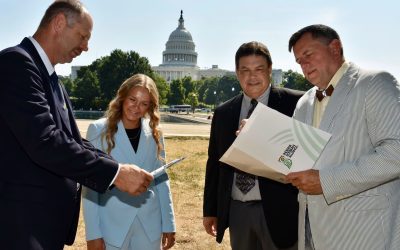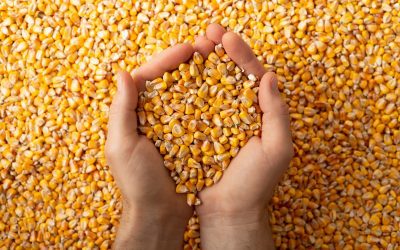Indiana farm leaders react to Vilsack’s Commodity Classic keynote speech
Posted: June 1, 2022
Category:
ICGA, Indiana Corn and Soybean Post - Spring 2022, ISA, News
Two Indiana farm leaders listened with interest to USDA Secretary Tom Vilsack as he addressed farmers as the keynote speaker at the annual Commodity Classic in New Orleans, La., on March 12. Indiana Soybean Association Membership and Policy (M&P) Chair Matthew Chapman, a farmer from Springport, Ind., and Indiana Corn Growers Association (ICGA) board member Mike Beard, a farmer from Frankfort, Ind., noted positives and negatives from Vilsack’s speech.

The Ag Secretary outlined plans for a new domestic fertilizer program and a three-part strategy for setting future federal farm policies. Those parts include increasing exports, promoting climate-smart commodities and combating consolidation that affects farm competition.
Vilsack plans to make trips to Dubai, Kenya, the United Kingdom and Spain to promote U.S. agricultural exports. He added that U.S. farm exports must be more diversified. “China has diversified and cannot be our only export market,” Vilsack explained. “We must explore and invest in other markets by selling our American pride and tremendous products.”

The USDA leader said “climate-smart commodities” is a new proposition from food companies wanting products grown through responsibly sourced farm practices. “We have already been working with food processors to set standards and to work on how to roll it out,” Vilsack said. “We want to create additional revenue opportunities and keep the program on a voluntary basis. Technology and innovation will explode in this arena with a lot of interest. USDA has made $1 billion available to build this effort for all sizes and types of farmers. This will help build this circular economy and keep more money here.”
Beard chose to look at USDA’s plan for climate-smart commodities as another opportunity for farmers. Introduced on February 7, this initiative plans to develop market opportunities for farm, ranch or forest products produced with climate-smart practices such as no-till, nutrient management, agroforestry or prescribed grazing.
“Secretary Vilsack asked all of agriculture to submit ideas and programs that would enhance the value of the crops that we grow,” Beard said. “For us here, it’s corn, soybeans, wheat and sorghum. But it can be nuts and berries and other fruits and tree fruits and other things that we can add value to here in this country and certify that they are climate proven, if you will.”
Chapman said Vilsack’s comments about developing more value-added products and a circular economy were two themes that he could support. “(Vilsack) said the Biden Administration is striving toward what they termed as a circular economy, where wecan try to keep as much of the value-added products and proteins here in the state, in the Midwest or in the U.S. And along with that, the jobs stay here; the money stays here; the investment stays here,” Chapman said.
Vilsack said consolidation of livestock processors has negatively affected the prices that farmers and ranchers are receiving, and consolidation by farm input providers has helped spur rising costs.
Domestic fertilizer program
The USDA announced a $250 million investment to support and expand American fertilizer production. Vilsack said, “We want to invest in fertilizer expansion in the U.S. that is independently-produced, made in America; and hopefully, embrace new innovation and support sustainable farming operations.”
USDA will use funds from the Commodity Credit Corporation (CCC) to develop a grant program that provides ‘gap’ financing to initiate new, independent domestic production of needed fertilizers.
The investment will be made through a new grant program. “We expect to have the application process available sometime this summer and we hope to see awards at the end of the year,” Vilsack said.
The United States is a major importer and dependent on foreign fertilizer. America is the second or third top importer for each of the three major components of fertilizer. The top producers of the components of fertilizer include China, Russia, Canada and Morocco, with Belarus also providing a significant share of potash. The standards of the domestic fertilizer production program are:
• Independent – outside the dominant fertilizer suppliers, increasing competition in a concentrated market
• Made in America – produced in the United States by domestic companies, creating good-paying jobs at home and reducing the reliance on potentially unstable or inconsistent foreign supplies
• Innovative –improve upon fertilizer production methods to jump start the next generation of fertilizers
• Sustainable – reduces the greenhouse gas impact of transportation, production, and use through renewable energy sources, feedstocks, formulations, and incentivizing greater precision in fertilizer use
• Farmer-focused – like other Commodity Credit Corporation investments, a driving factor will be providing support and opportunities for U.S. agriculture commodity producers

“Any time we can keep those value-added products here, we don’t rely on our neighbors or the uncertainty around the world to keep us in business,” Chapman said of homegrown fertilizers. “And it also comes from a security standpoint: if we have food security, that’s one less thing we have to worry about from a global perspective.”
Beard said domestic fertilizer sources is a part of that security and is interested to see the results of this program. “We’d all be excited to be able to source fertilizer right here in the U.S.,” Beard added. “The fact that we are so short on fertilizers and other inputs has been a major topic of discussion for farmers-those of us that have it, and those of us that don’t have it, yet.”

Expanding U.S. exports
Vilsack expects another strong year for U.S. ag export sales. “We had a record year for exports last year – $177 billion – we expect to break that record this year,” he said.
Vilsack said USDA will conduct trade missions to the United Kingdom in June, Philippines in July, Kenya in October and Spain in November. “There are a whole heck of a lot of people at USDA working very hard to make these trade missions successful, that it doesn’t necessarily require a single person to make them successful.”
He said he’s hopeful that the trade missions will expand export reliance to more than one or two markets.
Beard believes 2022 could be a good season, and exports are a part of that optimism. “Pricewise we have excellent crop insurance prices for corn and soybeans. Those were set in February,” he said. “It’s kind of an exciting time, but it’s a little scary.”
He thinks the biggest challenges for farmers is navigating the uncertainty. “There is a bevy of black swans that are congregating at the borders of the U.S. export opportunities,” he quipped. “Then we’re also discussing the cost of inputs and what government programs might be coming down the road.”
ICGA and M&P continue to monitor the USDA’s programs and actions so that they can provide Indiana farmers with the best possible policies.



